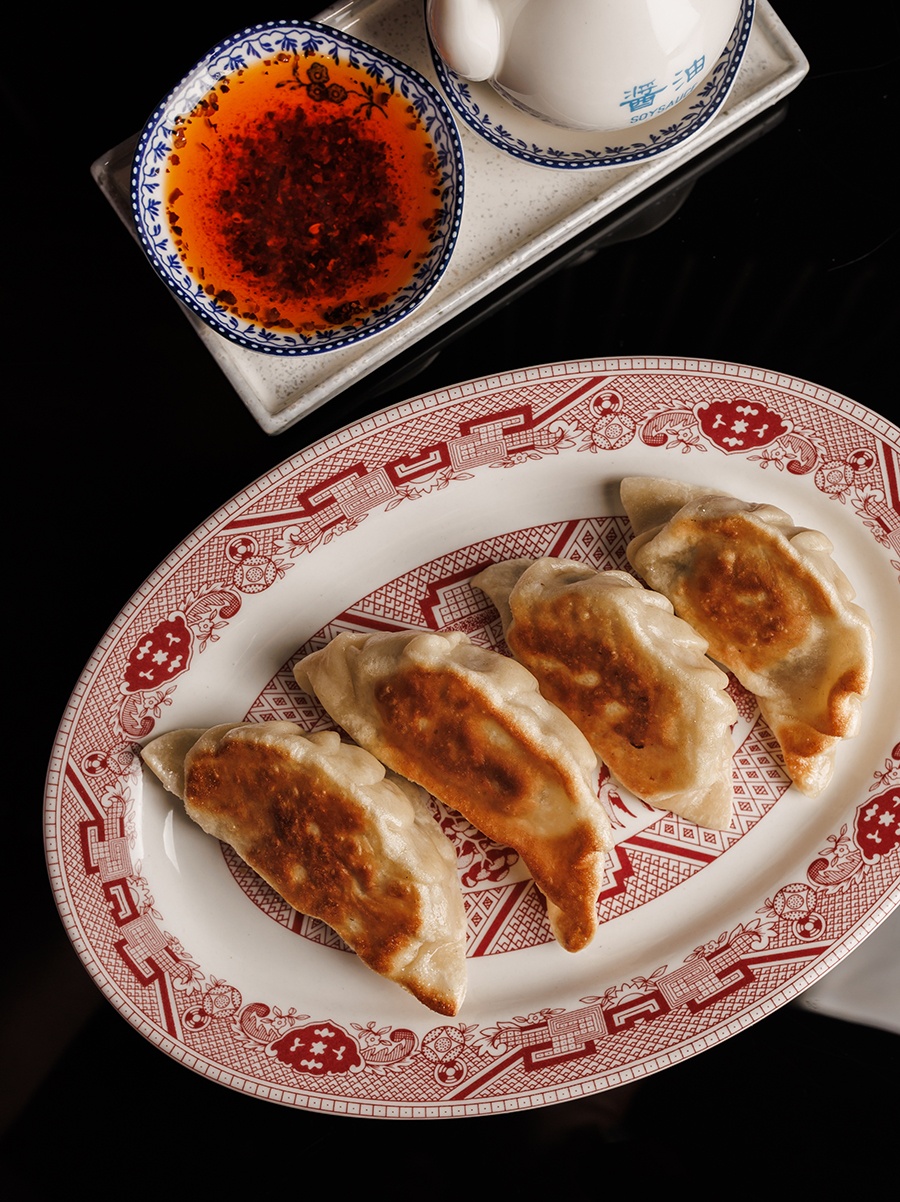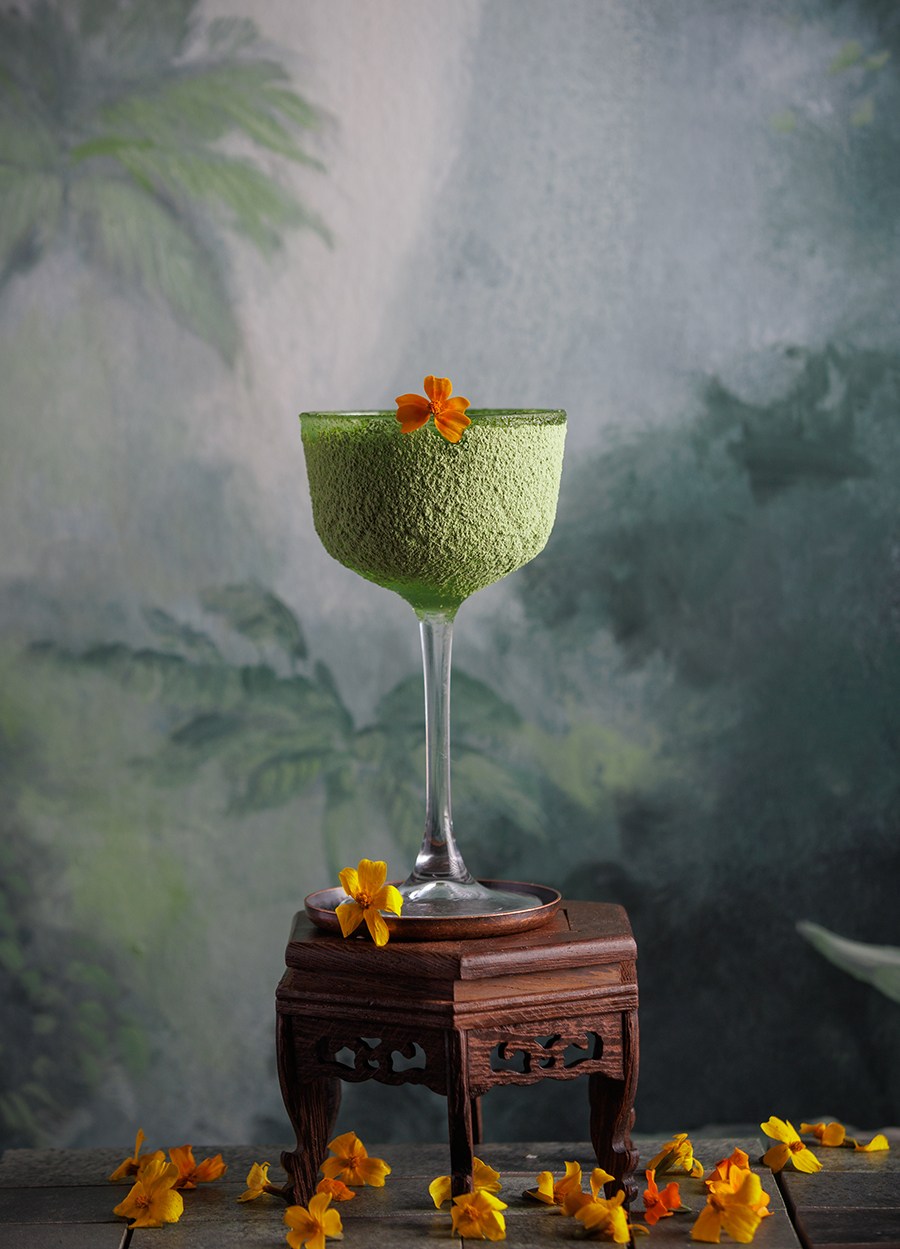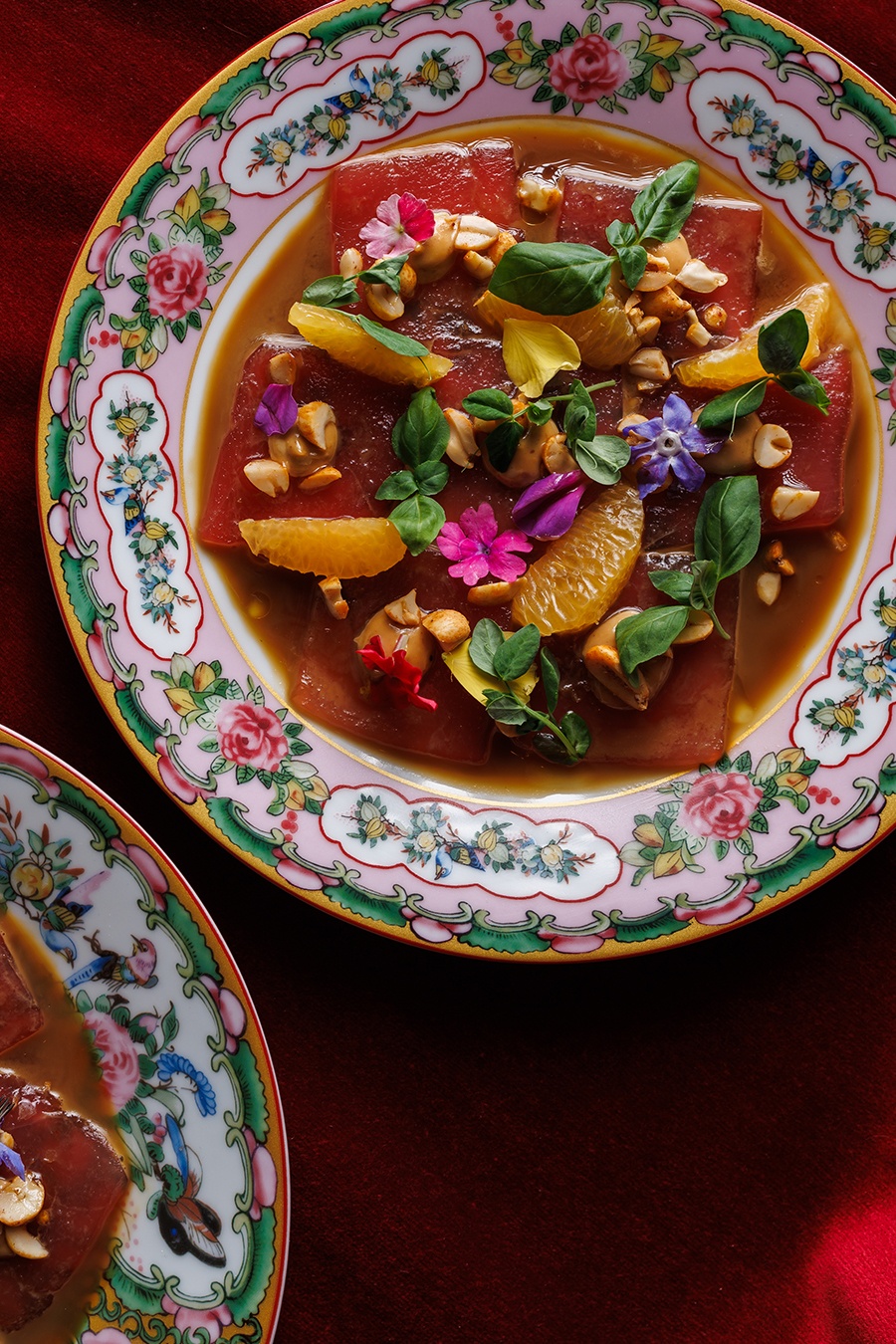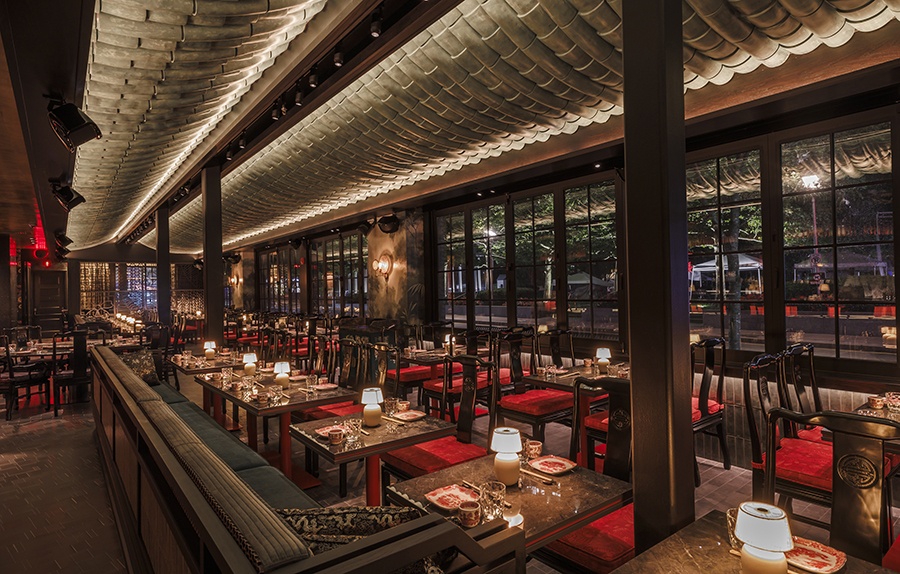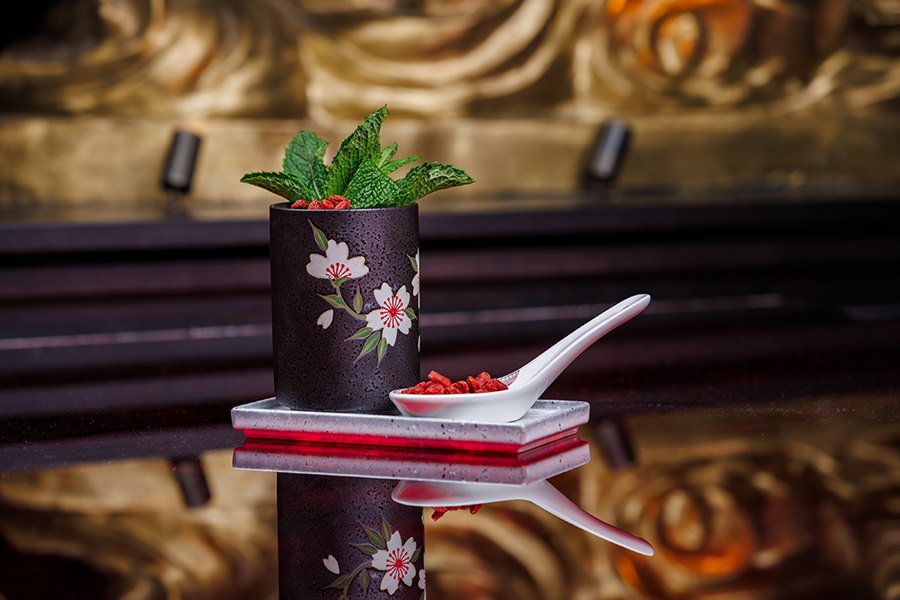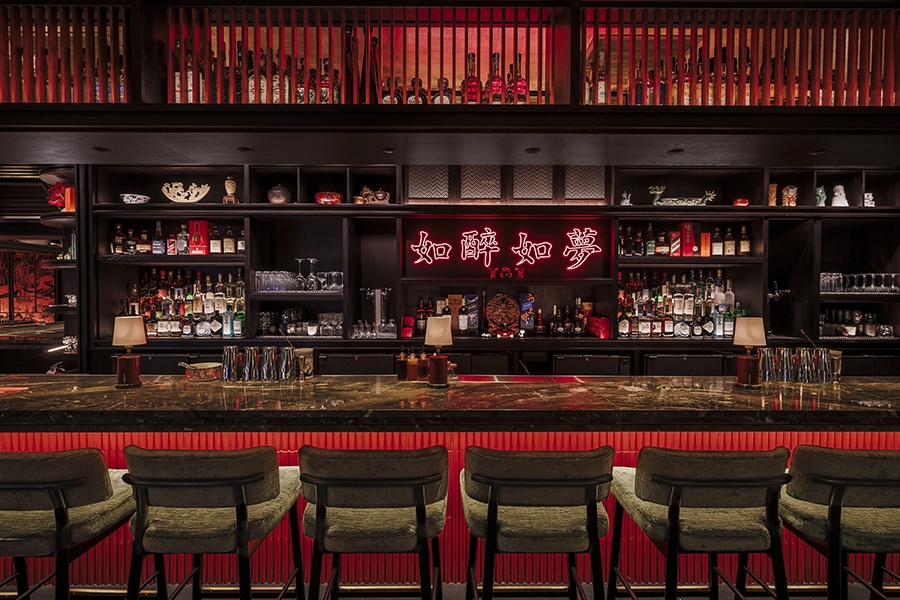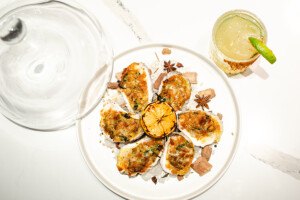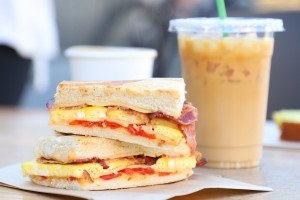Mr. H Comes to the Seaport, Dazzling with Dumplings and an Ultra-Glam Space
The latest Boston restaurant from the team behind Yvonne's and Coquette features a Chinese-inspired menu in a stylized movie-set milieu.
At Mr. H—the Chinese-inspired restaurant opening on September 12 in the Seaport, courtesy of COJE Management Group, the team behind Yvonne’s, Coquette, and more—much of the menu starts with dough. Take the griddled scallion pancakes, a product of a two-day process. On day one, chief culinary officer Tom Berry and his team make a simple dough of flour, salt, and water, separate it into balls, and let them rest overnight. The following morning, the dough balls are rolled out, brushed with roux, doused with scallions, and whipped back into multi-layer balls before they’re pressed and griddled to order.
Then, of course, there’s the dumpling dough. Berry could have just ordered premade wrappers, sure. But for a restaurant named in honor of Huang Mingxian—who invented soup dumplings at his Shanghai restaurant in the 1870s, according to food folklore—Berry knew the dough had to be perfect. His painstaking process involved altering a recipe he’d created in his home kitchen more than two years ago, since scaling up ingredient proportions can alter with the final product. Now, past the shimmering showpiece of a dining room, Mr. H’s dumpling command center features a table, a slick sci-fi-looking dough divider, and a sheet-roller. The latter is a tool more frequently used for pasta prep, but Berry says he “needed a way to [make dumpling dough] consistently and at a high level.”
Which is to say, Mr. H is presenting its menu of dumplings, dim sum, noodles, and more as an homage, according to COJE CEO and managing partner Chris Jamison, not as its own heritage, similar to the restaurant group’s sojourns through Mexican and Cuban cuisine over at Lolita and Mariel respectively. (If you’re craving delicious traditional cuisine, meanwhile, hit up Best of Boston winners in Chinatown for “mini juicy buns” at Dumpling Café, Taiwanese pan-fried dumplings at Taiwan Café, and anything on the sprawling menu at perennial favorite Peach Farm.) “What we’ve always done is we’ve looked back at our experiences, and our travels, and the things that we’ve internalized over the years. Where were the places and times that we loved, that we’ve felt most alive?” Jamison says. “We try and bring that back to Boston. I think we’ve always been very specific that we’re not claiming to be authentic anything. All of this is inspired by and in homage to our travels and the things that we’ve done.”
Like COJE’s other spots, including the French Polynesia floral fantasyland Caveau, Mr. H is a stylized movie-set milieu where the vibe and food share top billing. COJE’s in-house design team, headed by Jamison, partnered with the New York City firm Rockwell Group to transform the former Legal Test Kitchen space into a glitzy environment with a clever layout. A 28-seat dumpling lounge brings the luxe date-night vibes, with low green, gold, and red seating below a brass lotus chandelier. Walls are swathed in a dark velvet covering designed by Rare Culture. A low leather-paneled wall separates the lounge from the six-seat dumpling bar, where diners can watch chefs at work against the backdrop of a dragon mural painted by Julia Purinton.
The main dining room, meanwhile, is awash in brightness. With an enviable perch across from South Boston Maritime Park—one of few green spaces in the Seaport—the 68-seat space calls to mind a garden. The wall of windows opens to let in the outdoors, and part of the ceiling evokes the underside of Chinese clay roofs, with curved tiles painted jade green. Here, red lacquered tables and black chairs softened with silk cushions join banquette seating. More murals by Purinton add interest, with a four-person “godfather booth” to survey the action. The main bar seats 14, and the nearby 12-person private dining room with gold wallpaper and a brass-and-jade glass chandelier is a gilded jewel box for celebrations. Ceilings that gleam with 24-karat gold leaf unite all the spaces.
No matter if you hit the couches for a cozy dim-sum date night or the main dining room for a raucous meal, the dishes from executive chef Brian Tello and the team remain the same. The food is a return to form for Berry, who opened Ming Tsai’s famed Blue Ginger in Wellesley in 1998 and worked with the chef and restaurateur for five years. After taking a break from cooking Asian cuisine for a while, he comes to Mr. H refreshed, with more knowledge under his belt. On a recent research trip, he hit up restaurants, bars, and night markets in Taiwan, scribbling notes on flavors and snapping pictures, then hit the kitchen at home to try to recapture the magic.
The resulting menu features four sections: “Cold Treasures,” “Dumplings and Dim Sum,” “Night Market,” and “Wok & BBQ.” Beyond the nods to Chinese cuisines, Berry seeks inspiration elsewhere, too. There’s the Japanese-leaning shumai, a dish featuring smoked basmati that he first encountered in Lebanon, and, of course, lobster and oysters that come from closer to home. “It’s a nod to the respect of the traditions and the foodways of China and Taiwan,” Berry says of the menu. “But we’re obviously not gonna be able to re-create that exactly. And nor would we want to. We’re trying to do something new.”
Starting in the “Cold Treasures” section of the menu, diners can savor that “something new” ethos with a plate of drunken octopus. Based on drunken chicken, the dish sees octopus slowly simmered in Shaoxing wine, fermented black bean, garlic, and ginger, and served cold with goji berries for pop. The youtiao avocado toast, too, remixes a Chinese cruller-like breakfast confection with the favorite brunch bite, topped here with mushroom chili crisp. The heartbreak jelly noodles, springy noodles made of mung bean flour, are a playground for fiery flavors. That dish and others gets a dollop of house-made facing-heaven chili oil, made with a dried imported pepper named as such because the fruit grows upward. The oil is just one example of Berry’s condiment- and sauce-making wizardry, from spicy doubanjiang mayo to the American-Chinese staple of duck sauce, packed with pickled plums and tons of plum wine, ginger, and soy.
The “Dumplings and Dim Sum” section includes a mix of American-Chinese favorites and dishes that lean more traditional. Berry’s bespoke dough is an excellent vehicle for soup dumplings featuring Kurobuta pork, served with Sichuan pepper and cilantro. And a familiar chicken dish joins spiced dry wings drizzled with Thai hot honey: “I really wanted to have chicken fingers, which is Polynesian, and a nod to Bob Lee’s Islander that used to be in Chinatown a million years ago,” Berry says. While the origin of the quirky food is unclear—it’s at once Polynesian, American-Chinese, and Bostonian—it’s likely that restaurateur and Chinese immigrant Bob Lee brought it to the area around 1960. Berry’s version, served in stylized baskets, adds wheat dextrin to the batter for extra crunch.
It’s no surprise that the “Night Market” section features dishes inspired by, well, night markets. At the dazzling Gongguan Night Market in Taipei, Berry gobbled griddled scallion pancakes at family-run street-food spot Hsiung Chi, and ate crispy popcorn spare ribs at the Roahe Street Night Market, also in Taipei. Mr. H showcases versions of both, including a gussied-up scallion pancake that includes fried egg, American cheese, pickled peppers, and sweet basil.
Meanwhile, after years of dishing out rice with a million sauces, Berry wanted to keep his fried rice in the “Wok and BBQ” section relatively simple. The house fried rice features shredded chicken, Chinese sausage, egg, and sprouts, drizzled with barrel-aged soy. For the mushroom version, wood ear, king trumpet, and shiitake mushrooms stud basmati rice that’s hard-smoked while raw, lending a savory, smoky scent.
Of course, it wouldn’t be a COJE venue without theatricality. Two large-format plates, Cantonese fried chicken and imperial steak, are feasts with all the flourishes—sides of herbs, oils, and other accoutrements. And tempting as it might be to inhale the dessert all by yourself, the Hong Kong bubble waffles whipped up by COJE’s pastry chef Mai Nguyen are meant to be shared. The made-to-order beauties come with a chocolate ice cream that features White Rabbit candy (a milk-based nostalgic Chinese confection) plus a trove of mango popping pearls, chocolate Pop Rocks, and other toppings served in a wooden tea tower. On the cocktail menu, herbaceous pandan-infused jasmine tea and ginger keeps the large-format Golden Panda Bowl from tasting like a drinkable dessert. The scorpion-bowl-inspired sip joins beverage director Ray Tremblay’s program of unexpected cocktails, many featuring teas and infusions.
In other words, there’s a lot going on at Mr. H, but Berry is more than happy to offer a curated list of must-tries for a couple on a date night. The cold cucumbers with black vinaigrette should be on every table, he says. And the tangerine tuna and drunken octopus. Chicken wings or chicken fingers are a definite, and obviously dumplings. The honey prawns are “awesome.” The char siu pork has to happen. You need a noodle, so get the duck dandan noodles. And a vegetable, too—make it the spicy-sweet Sichuan eggplant. And the imperial steak. And, hey, are we sure this is a table just for two?
“It’d be easier to pick for four!” he says with a laugh. “That’s the thing with small-plate dining in general and Chinese restaurants—they’ve always been a sharing experience.”
Opening September 12 and operating daily from 11:30 a.m. to 2 a.m. (food until 1:30 a.m.). 225 Northern Ave., Seaport District, Boston, mrhchinese.com.

